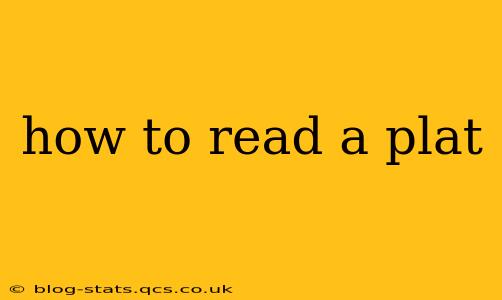A plat is a detailed map showing the boundaries and divisions of a piece of land, often used in real estate transactions and legal descriptions. Understanding how to read a plat is crucial for anyone involved in property ownership, development, or legal matters. This guide will walk you through the essential elements of a plat and how to interpret them.
What is a Plat?
A plat, also known as a plot plan, is a legally recorded map that shows the location, size, and boundaries of a parcel of land. It’s a visual representation of a property's survey, detailing features like:
- Lot lines: The boundaries of individual parcels.
- Street names and rights-of-way: The location of roads and public access areas.
- Easements: Access rights granted to utilities or neighboring properties.
- Setbacks: Minimum distances structures must be from property lines.
- Monuments: Permanent markers used to define property boundaries.
- Dimensions: Lengths and angles of property lines.
- Lot numbers: Unique identifiers for each parcel.
- Legal descriptions: The written description of the property's boundaries.
Key Elements of a Plat & How to Interpret Them
1. Identifying the Lot and Block Number
Each lot on a plat is assigned a unique lot number, and the collection of lots is usually grouped into blocks. Find the lot number of the property you're interested in. This is essential for identifying the specific parcel. The block number helps to locate the specific area within a larger development.
2. Understanding Property Lines and Boundaries
Lot lines are shown as solid lines on the plat. These lines represent the legal boundaries of your property. Pay close attention to these lines to understand the exact extent of your ownership.
3. Interpreting Dimensions and Bearings
Pplats include dimensions (lengths) and bearings (angles) of property lines. Bearings are usually expressed in degrees, minutes, and seconds, relative to North. These measurements provide precise details on the property's shape and size. You will likely need a compass or protractor for accurate interpretation.
4. Recognizing Easements and Rights-of-Way
Easements are marked on the plat, often as shaded areas or labeled lines. These areas grant access rights to other parties, such as utility companies for power lines or water pipes, or even neighboring properties for shared access. Understanding easements is critical to know your property's limitations.
5. Locating Setback Lines
Setback lines indicate the minimum distance a structure can be built from property lines. These lines are crucial for construction planning and ensuring compliance with local building codes.
6. Identifying Monuments
Monuments are physical markers, such as iron pins or concrete markers, that define property corners. While not always explicitly shown on every plat, their location may be indicated. These are critical for on-the-ground verification of boundaries.
7. Deciphering Legal Descriptions
The plat usually includes a legal description of the property. This is a precise written description of the property's boundaries, often using metes and bounds or lot and block descriptions. This legal description is crucial for legal purposes and is often referenced in deeds and other legal documents.
How to Access a Plat?
You can usually access plats through several methods:
- County Recorder's Office: This is the primary source for recorded plats.
- County Assessor's Office: They often have plats on file as well, usually linked to tax assessment information.
- Online Real Estate Databases: Some websites allow you to search for and view plats online, often for a fee.
- Your Real Estate Agent or Title Company: They typically have access to plats as part of the property transaction.
What if I have trouble interpreting a plat?
If you are having difficulties interpreting a plat, consider seeking assistance from:
- A surveyor: They are professionals who specialize in land surveying and can help interpret the plat's details.
- A real estate attorney: Legal expertise can be crucial in understanding the legal implications of plat information.
Understanding how to read a plat is a valuable skill for anyone dealing with land ownership. By understanding the key elements and interpreting them accurately, you can ensure clear understanding of your property boundaries and rights. Remember to always consult with professionals if you have any doubts or require expert assistance.
